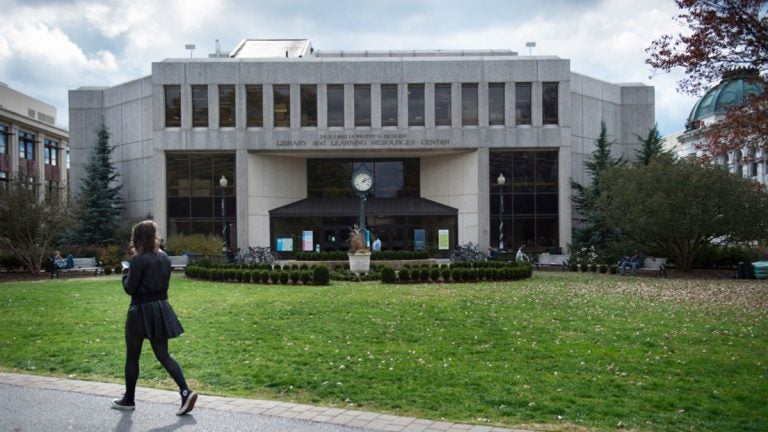Critics warn that well-meaning reforms may be lowering the quality of college
Signs emerge that some are cutting corners to produce more graduates more quickly.

A student walks past the Bender Library on the American University campus in Washington, D.C. American is one of 32 colleges and universities with an accelerated program that lets students earn bachelor’s degrees in thee years instead of four, which one management expert has criticized for helping only undergraduates who are already very well prepared. (Nikki Kahn/The Washington Post via Getty Images)
This story originally appeared in The Hechinger Report.
—
At a time when parents, politicians and universities all want more students to go to college and graduate on time, the idea of letting them take college courses while in high school seems a great solution.
Dual-credit or dual-enrollment programs let high school students earn college credit, get them used to college-level work, give them a head start toward degrees and save them money on courses they won’t need to pay for later.
In Ohio, however, lawmakers were surprised to learn that high school kids were earning college credits, at taxpayer expense, by taking gym.
That and other loopholes have been closed this summer in response to legislation in Ohio that restricted who can sign up for dual enrollment there and what courses count toward college.
But it’s among the ways critics warn some well-meaning reforms designed to solve the many challenges in higher education are threatening to water down its quality or benefiting students who don’t need help.
“Every well-intentioned policy carries unintended consequence,” said Chester Finn Jr., a former assistant U.S. secretary of education who is among those raising caution flags.
Remedial education, which forces some college students to re-take math and English they should have learned in high school, is being eliminated in states including Florida and California. While the tutoring and on-the-run support that have replaced it may smooth their paths, at least one university president wonders whether future engineers will sufficiently master calculus they need.
Some institutions are letting students graduate in three years instead of four; this can save them money and increase capacity on campus but a Johns Hopkins University analysis says these schools are mostly just condensing their four-year timetables, making it hard for any but the most academically prepared students to finish in three years.
Other universities are reducing the number of credits required to earn degrees in certain majors; though this also helps speed students through — especially at institutions where the number of required credits has crept up — some faculty say it’s depriving graduates of skills they’ll need in their careers.
There are also complaints about white-collar apprenticeships being offered to students while in high school, meant to expose them to the workplace and encourage them to go to college, but so time-consuming they cut into class schedules. Some universities have stopped giving Fs, letting failing students keep trying until they pass. Students can increasingly get college credit for previous training or experience, but the U.S. Department of Education inspector general has raised concerns about a lack of oversight of this. And a committee of the principal national faculty union is at work on a position paper documenting problems with some dual-enrollment programs.
“I don’t know anyone who doesn’t want to improve education, but our good intentions can make us unintentionally do the wrong things,” said Frederick Hess, founding director of the education policy studies program at the Washington think tank the American Enterprise Institute.

Coauthor of a new study urging steps to improve low college graduation rates, but without reducing quality, Hess said: “Policymakers want to see those numbers go up, parents want them to go up, so there’s no one really eager to stand there with a magnifying glass and make sure everything’s kosher.”
There’s no question dual enrollment makes numbers go up. High school students who take dual-enrollment courses are more likely than their classmates to go to college, and they earn degrees or certificates more quickly, research by the Community College Research Center at Teachers College, Columbia University, or CCRC, found.
It’s an innovation that’s increasingly crucial to colleges, too. The principal reason their institutions are pushing dual-credit programs, administrators said in a survey, is that, with traditional enrollments plummeting, it gets high school students on the hook and helps recruit them. Eighty-four percent of students go on to attend the colleges from which they took their dual-enrollment classes, the CCRC study found.
A result is that administrators “are all well-meaning, but their focus is not on the quality of instruction,” said Jim Klein, a history teacher at Del Mar College in Texas — a state where dual-enrollment participation has increased 753 percent since 2000 — who is writing a position paper for the American Association of University Professors, or AAUP, raising alarms about this. “Their charge is to grow the dual-credit programs and the easiest way to do that is reduce standards.”
Among those standards is the one that governs who provides these classes. Some take place on college campuses or online, but many are overseen by high school teachers. A third of colleges and universities that won’t accept credit from dual-enrollment high school courses said in a survey it’s because they were uncertain about the quality of their content or the qualifications of instructors.
Thirty-five states require that instructors meet the same requirements as faculty at the partner college, nine that they have a master’s degree or higher, and six that they’ve taken graduate courses in the subject they’re teaching, according to the Education Commission of the States and Midwestern Higher Education Compact.
But with the dramatic growth of dual enrollment, many high schools can’t find teachers with credentials like those. The Higher Learning Commission ordered three years ago that dual-enrollment instructors in the 19 states where it accredits universities and colleges have at least master’s degrees, but Indiana, Minnesota and other states and many colleges have gotten extensions until mid-2022.
“There are a lot of laudable reasons” for dual enrollment, said Finn, a senior fellow at the Thomas B. Fordham Institute, which promotes education quality. “On its face, it’s an everybody-wins strategy. The high school kids win and the colleges win and perhaps upward mobility wins as more kids in high school discover they could succeed in college. The issue is, are we doing something educationally marginal, maybe even fraudulent, when we assert that these are college courses?”
Dual enrollment also often benefits higher-income students more than lower-income ones who presumably need the most encouragement to go to college at the lowest price, the CCRC found. New Mexico’s Legislative Finance Committee reports that students who take dual-enrollment courses there already have greater academic skills than those who don’t and would likely go to and graduate from college even without the program.
Another way that high school students are being encouraged to go on to college is by exposing them to careers through apprenticeships. In Colorado, which is pushing this idea, one statewide program places high school students in banks and insurance offices for from 16 to 24 hours a week. That’s depriving them of a big chunk of their educations, said Peter Huidekoper Jr., a retired English teacher who blogs about education and is the Colorado coordinator of the Education Policy Fellowship Program.
“The purpose of a K-12 education is to offer a solid foundation for these young people, yet we’re saying they should come to school for only half the time,” Huidekoper said.
Once they do arrive on campus, many students who show poor math and English skills are diverted into no-credit remedial (also called “developmental”) courses, which makes them 74 percent more likely to drop out of college than students who aren’t, according to the advocacy group Education Reform Now; those who do finish take nearly a year longer.
Florida, California and some other states are experimenting with reforms to this, California by substituting tutoring and coaching to move these students more quickly into the regular curriculum. At the California State University System, that’s part of a plan to more than double the proportion of freshmen who finish in four years from the current 19 percent to 40 percent by 2025.
But letting students jump straight into subjects with which they still need help makes some observers nervous.
“There is some disagreement over whether that is a good move or not,” one, Dianne Harrison, president of California State University, Northridge, told a conference of education journalists. The current model needs to change, she said, but for science, technology, engineering and math majors who arrive behind and need to catch up, “How can you do that without any remedial work? That’s the $64,000 question — someone wants to be an engineer but doesn’t know calculus?”
Some institutions are trying to improve success rates by changing how courses are taught. The Gateway to Success Initiative at the Community College of Aurora in Colorado increased the focus of instructors on teaching writing while reducing the amount of writing students were assigned in introductory courses, according to Nathanial Bork, a part-time philosophy instructor.
Bork complained that this was dumbing down his class. He was fired, which resulted in a censure for the college from the AAUP; the faculty union said evidence suggested that Bork lost his job in retaliation for complaining, though the college denies it.
“They say if everyone has a college degree we’ll be a really educated society,” said Bork. “But people have to actually learn things.”
There are other reforms meant to reduce the excessive amount of time most students spend in college, a significant and costly problem; 85 percent take three years or more to graduate from two-year community colleges or never finish them at all, and more than 62 percent take five years or more to earn four-year degrees or drop out altogether, the National Student Clearinghouse calculates.
One solution is to cut down on the number of credits needed to graduate in certain majors that have steadily added requirements over time.
That’s what happened at the University of California, Santa Cruz, which is a 2015 draft strategic plan said it was “asking every program on campus to review its degree requirements and, where possible, to reduce them. … Some students falter in very challenging majors after having progressed a good deal toward their degrees.” (The document is no longer on the university’s website, but is available from a web archive.)
For the Computer Science Department, that meant eliminating requirements that students take a course in computational models and an introduction to compilers — software that translates computer code from one programming language into another. Though the change was approved by the majority of the department faculty, five in the minority wrote a protest letter calling it “disastrous.”
“They want to get people through there, and they’re trying to cut down as many requirements as possible,” said David Levy, an undergraduate studying computer science and game design, who also opposed the move. “The end result is that they are diluting the value of their degrees and programs.”
Vice provost and dean of undergraduate education Richard Hughey reiterated that faculty decides what courses to make optional or mandatory and that the complex tangle of prerequisites also means that too many required courses can derail students. While universities need to ask, “ ‘Are the courses we’re requiring the students to take, are those all necessary?’ ” Hughey said, “There was no top-down anything. There was no dean that came to Computer Science and said, ‘You should make compilers an elective.’”
The most dramatic idea to speed students to graduation is to shrink college itself from four years to three, an option now provided by at least 32 institutions — including Ball State, American, New York, Kent State and Purdue universities and the University of Iowa — according to Paul Weinstein, director of the Johns Hopkins University graduate program in public management, who in a new report gives this reform a failing grade.
“They are taking the four-year curriculum and simply squeezing it into three years and saying to students, ‘If you think you can do this, be our guest, but we’re not really providing you with support, with counseling about how to schedule your courses.
We’re not rethinking the curriculum at all for a three-year model,’” Weinstein said.
Colleges instead should cut unnecessary electives and study abroad, require students to declare their majors earlier and give more credit for high school Advanced Placement or International Baccalaureate courses, he said.
“They’re misleading students who try to do the three-year thing,” Weinstein said. “They plan on it and they can’t do it, so they drop out,” often piling up debt along the way.
Hess thinks what he called higher education’s “crisis-of-the-day mode” is what’s encouraging reforms that could be too hasty and risk lowering the value of degrees.
He said he feared that the way some in higher education see it is “that the two easiest ways to improve your graduation rate is to stop admitting students who are a bad risk — or start handing out diplomas like a PEZ dispenser.
—
Produced by The Hechinger Report, a nonprofit, independent news organization focused on inequality and innovation in education. Sign up here for our higher-education newsletter.
WHYY is your source for fact-based, in-depth journalism and information. As a nonprofit organization, we rely on financial support from readers like you. Please give today.




